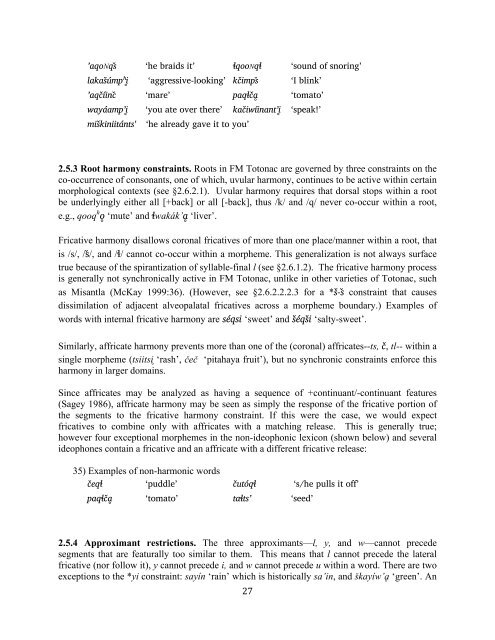The phonology and morphology of Filomeno Mata Totonac
The phonology and morphology of Filomeno Mata Totonac
The phonology and morphology of Filomeno Mata Totonac
Create successful ePaper yourself
Turn your PDF publications into a flip-book with our unique Google optimized e-Paper software.
’aqoNqs" ‘he braids it’ "qooNq" ‘sound <strong>of</strong> snoring’<br />
lakas%úmp'i& ‘aggressive-looking’ kc%imps" ‘I blink’<br />
’aqc%íinc" ‘mare’ paq"c%a& ‘tomato’<br />
wayáamp’i& ‘you ate over there’ kac%iwíinant’i& ‘speak!’<br />
mis%kiniitánts' ‘he already gave it to you’<br />
2.5.3 Root harmony constraints. Roots in FM <strong>Totonac</strong> are governed by three constraints on the<br />
co-occurrence <strong>of</strong> consonants, one <strong>of</strong> which, uvular harmony, continues to be active within certain<br />
morphological contexts (see §2.6.2.1). Uvular harmony requires that dorsal stops within a root<br />
be underlyingly either all [+back] or all [-back], thus /k/ <strong>and</strong> /q/ never co-occur within a root,<br />
e.g., qooq h o& ‘mute’ <strong>and</strong> "wakák’a& ‘liver’.<br />
Fricative harmony disallows coronal fricatives <strong>of</strong> more than one place/manner within a root, that<br />
is /s/, /s"/, <strong>and</strong> /#/ cannot co-occur within a morpheme. This generalization is not always surface<br />
true because <strong>of</strong> the spirantization <strong>of</strong> syllable-final l (see §2.6.1.2). <strong>The</strong> fricative harmony process<br />
is generally not synchronically active in FM <strong>Totonac</strong>, unlike in other varieties <strong>of</strong> <strong>Totonac</strong>, such<br />
as Misantla (McKay 1999:36). (However, see §2.6.2.2.2.3 for a *s%-s" constraint that causes<br />
dissimilation <strong>of</strong> adjacent alveopalatal fricatives across a morpheme boundary.) Examples <strong>of</strong><br />
words with internal fricative harmony are séqsi ‘sweet’ <strong>and</strong> s%éqs%i ‘salty-sweet’.<br />
Similarly, affricate harmony prevents more than one <strong>of</strong> the (coronal) affricates--ts, c%, tl-- within a<br />
single morpheme (tsiitsi" ‘rash’, $e$ ‘pitahaya fruit’), but no synchronic constraints enforce this<br />
harmony in larger domains.<br />
Since affricates may be analyzed as having a sequence <strong>of</strong> +continuant/-continuant features<br />
(Sagey 1986), affricate harmony may be seen as simply the response <strong>of</strong> the fricative portion <strong>of</strong><br />
the segments to the fricative harmony constraint. If this were the case, we would expect<br />
fricatives to combine only with affricates with a matching release. This is generally true;<br />
however four exceptional morphemes in the non-ideophonic lexicon (shown below) <strong>and</strong> several<br />
ideophones contain a fricative <strong>and</strong> an affricate with a different fricative release:<br />
35) Examples <strong>of</strong> non-harmonic words<br />
c%eq" ‘puddle’ c%utóq" ‘s/he pulls it <strong>of</strong>f’<br />
paq"c%a& ‘tomato’ ta"ts’ ‘seed’<br />
2.5.4 Approximant restrictions. <strong>The</strong> three approximants—l, y, <strong>and</strong> w—cannot precede<br />
segments that are featurally too similar to them. This means that l cannot precede the lateral<br />
fricative (nor follow it), y cannot precede i, <strong>and</strong> w cannot precede u within a word. <strong>The</strong>re are two<br />
exceptions to the *yi constraint: sayín ‘rain’ which is historically sa’in, <strong>and</strong> #kayíw’! ‘green’. An<br />
! #+!

















